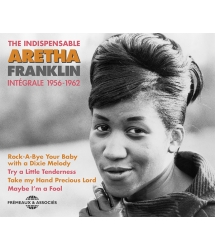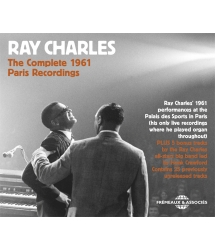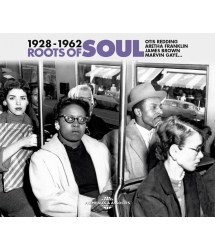- Our Catalog
- Philosophy
- Philosophers of the 20th century and today
- History of Philosophy (PUF)
- Counter-History and Brief Encyclopedia by Michel Onfray
- The philosophical work explained by Luc Ferry
- Ancient thought
- Thinkers of yesterday as seen by the philosophers of today
- Historical philosophical texts interpreted by great actors
- History
- Books (in French)
- Social science
- Historical words
- Audiobooks & Literature
- Our Catalog
- Jazz
- Blues
- Rock - Country - Cajun
- French song
- World music
- Africa
- France
- Québec / Canada
- Hawaï
- West Indies
- Caribbean
- Cuba & Afro-cubain
- Mexico
- South America
- Tango
- Brazil
- Tzigane / Gypsy
- Fado / Portugal
- Flamenco / Spain
- Yiddish / Israel
- China
- Tibet / Nepal
- Asia
- Indian Ocean / Madagascar
- Japan
- Indonesia
- Oceania
- India
- Bangladesh
- USSR / Communist songs
- World music / Miscellaneous
- Classical music
- Composers - Movie Soundtracks
- Sounds of nature
- Our Catalog
- Youth
- Philosophy
- News
- How to order ?
- Receive the catalog
- Manifesto
- Dictionnary











- Our Catalog
- Philosophy
- Philosophers of the 20th century and today
- History of Philosophy (PUF)
- Counter-History and Brief Encyclopedia by Michel Onfray
- The philosophical work explained by Luc Ferry
- Ancient thought
- Thinkers of yesterday as seen by the philosophers of today
- Historical philosophical texts interpreted by great actors
- History
- Books (in French)
- Social science
- Historical words
- Audiobooks & Literature
- Our Catalog
- Jazz
- Blues
- Rock - Country - Cajun
- French song
- World music
- Africa
- France
- Québec / Canada
- Hawaï
- West Indies
- Caribbean
- Cuba & Afro-cubain
- Mexico
- South America
- Tango
- Brazil
- Tzigane / Gypsy
- Fado / Portugal
- Flamenco / Spain
- Yiddish / Israel
- China
- Tibet / Nepal
- Asia
- Indian Ocean / Madagascar
- Japan
- Indonesia
- Oceania
- India
- Bangladesh
- USSR / Communist songs
- World music / Miscellaneous
- Classical music
- Composers - Movie Soundtracks
- Sounds of nature
- Our Catalog
- Youth
- Philosophy
- News
- How to order ?
- Receive the catalog
- Manifesto
- Dictionnary
INCLUDING 13 PREVIOUSLY UNRELEASED TRACKS, PLUS 14 BONUS TRACKS
RAY CHARLES
Ref.: FA5733
EAN : 3561302573328
Artistic Direction : JOEL DUFOUR
Label : Frémeaux & Associés
Total duration of the pack : 4 hours 3 minutes
Nbre. CD : 4
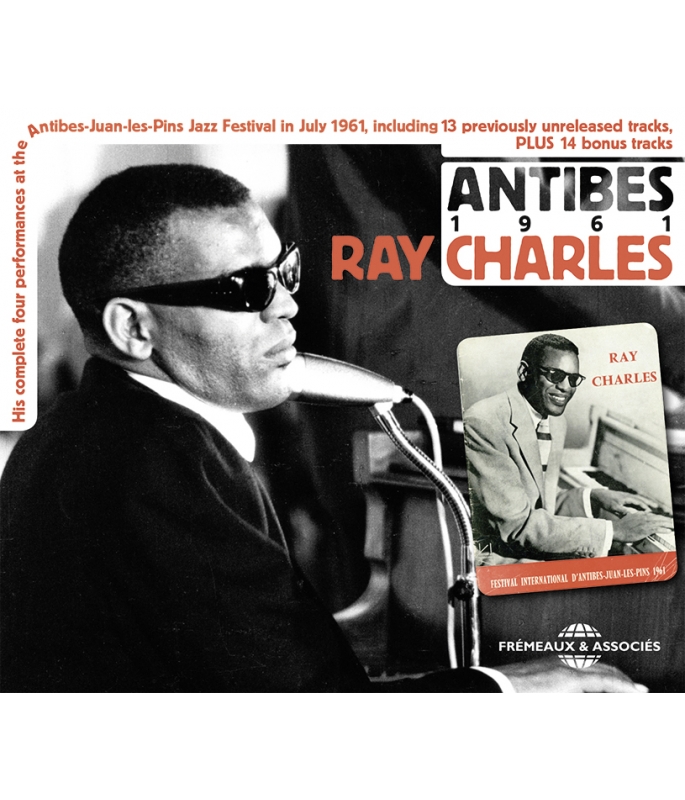
INCLUDING 13 PREVIOUSLY UNRELEASED TRACKS, PLUS 14 BONUS TRACKS
INCLUDING 13 PREVIOUSLY UNRELEASED TRACKS, PLUS 14 BONUS TRACKS
Produced by Joël Dufour, the greatest expert on the work of “The Genius” — aka Ray Charles — this set brings together for the first time the complete live concert that Ray performed in Antibes/Juan-les-Pins in July 1961. It was Ray Charles’ first booking outside the USA — a cult concert — and it was destined to be the first in a lengthy series that created the long-lasting respect reserved for the artist by audiences in France. When compiling this set, Joël Dufour chose to include a large number of bonus tracks and previously unreleased material — notably demonstrating that Ray, already a great keyboard player, was also a fantastic accompanist. This 4CD box a must-have item for every “Brother Ray” fan. Patrick FRÉMEAUX
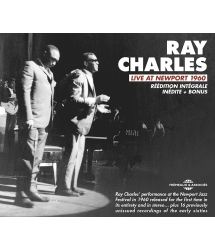
RÉÉDITION INTÉGRALE INÉDITE + BONUS
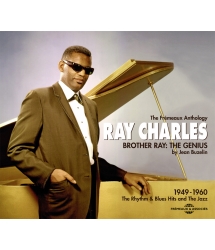
BROTHER RAY : THE GENIUS
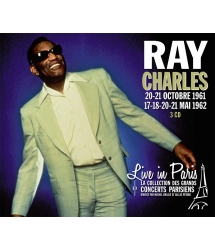
20-21 OF OCTOBER 1961 / 17-18-20-21 OF MAY 1962



-
PisteTitleMain artistAutorDurationRegistered in
-
1Spoken Introductions by André Francis and Joe AdamsRay CharlesAndré Francis00:02:592018
-
2Doodlin'Ray CharlesHorace Silver00:07:242018
-
3The StoryRay CharlesJames Moody00:04:552018
-
4Lil Darlin'Ray CharlesHefti Neal00:08:272018
-
5One Mint JulepRay CharlesRudolph Toombs00:03:162018
-
6Let the Good Times RollRay CharlesSam Theard00:02:412018
-
7Georgia on My MindRay CharlesHoagy Carmichael00:05:212018
-
8My BonnieRay CharlesRay Charles00:03:592018
-
9(Night Time Is) the Right TimeRay CharlesNapoleon Brown00:04:132018
-
10Sticks and StonesRay CharlesTitus Turner00:03:512018
-
11Hallelujah I Love Her SoRay CharlesRay Charles00:03:062018
-
12What'd I SayRay CharlesRay Charles00:05:492018
-
13Ooh Lawdy My BabyRay Charles, Tommy RidgleyTommy Ridgley00:02:462018
-
14I'm Gonna Cross That RiverRay Charles, Tommy RidgleyGladys De Vore00:02:582018
-
15The Things That I Used to DoRay Charles, Guitar SlimEddie Jones00:03:032018
-
16Well I Done Got over ItRay Charles, Guitar SlimEddie Jones00:02:292018
-
17The Story of My LifeRay Charles, Guitar SlimEddie Jones00:03:022018
-
18A Letter to My GirlfriendRay Charles, Guitar SlimEddie Jones00:02:102018
-
PisteTitleMain artistAutorDurationRegistered in
-
1Spoken Introductions by André Francis and Joe Adams 2Ray CharlesAndré Francis00:02:412018
-
2The Story 2Ray CharlesJames Moody00:04:492018
-
3In a Little Spanish TownRay CharlesM. Wayne00:04:112018
-
4Lil' Darlin 2Ray CharlesHefti Neal00:06:582018
-
5PopoRay CharlesShorty Rogers00:04:172018
-
6Let the Good Times Roll 2Ray CharlesSam Theard00:02:432018
-
7Georgia on My Mind 2Ray CharlesHoagy Carmichael00:04:552018
-
8Sticks and Stones 3Ray CharlesTitus Turner00:03:492018
-
9My Baby (I Love Her Yes I Do)Ray CharlesRay Charles00:04:072018
-
10Yes IndeedRay CharlesSy Oliver00:02:392018
-
11I Believe to My SoulRay CharlesRay Charles00:03:322018
-
12What'd I Say 2Ray CharlesRay Charles00:05:322018
-
13It Should've Been MeRay CharlesEddie Curtis00:02:412018
-
14Early in the Mornin'Ray CharlesL. Hickman00:02:492018
-
15My Bonnie 2Ray CharlesRay Charles00:03:462018
-
PisteTitleMain artistAutorDurationRegistered in
-
1Spoken Introduction by Joe AdamsRay CharlesJoe Adams00:01:232018
-
2Popo 2Ray CharlesShorty Rogers00:03:552018
-
3Lil Darlin' 3Ray CharlesHefti Neal00:08:062018
-
4Let the Good Times Roll 3Ray CharlesSam Theard00:02:412018
-
5RubyRay CharlesC. Conrad00:06:152018
-
6My Bonnie 3Ray CharlesRay Charles00:03:252018
-
7With You on My MindRay CharlesNat King Cole00:04:482018
-
8Sticks and Stones 4Ray CharlesTitus Turner00:03:252018
-
9I WonderRay CharlesCecil Gant00:03:212018
-
10What'd I Say 3Ray CharlesRay Charles00:05:062018
-
11Wee Baby BluesRay Charles, Joe TurnerJoe Turner00:02:182018
-
PisteTitleMain artistAutorDurationRegistered in
-
1Spoken Introductions by André Francis and Joe Adams 3Ray CharlesAndré Francis00:02:192018
-
2Popo 3Ray CharlesShorty Rogers00:04:152018
-
3Lil Darlin' 4Ray CharlesHefti Neal00:07:442018
-
4Hornful SoulRay CharlesRay Charles00:05:142018
-
5Let the Good Times Roll 4Ray CharlesSam Theard00:02:542018
-
6Georgia on My Mind 3Ray CharlesHoagy Carmichael00:05:112018
-
7My Bonnie 4Ray CharlesRay Charles00:03:352018
-
8With You on My Mind 2Ray CharlesNat King Cole00:05:022018
-
9Tell the TruthRay CharlesL. Pauling00:03:432018
-
10I Wonder 2Ray CharlesCecil Gant00:03:392018
-
11Sticks and Stones 2Ray CharlesTitus Turner00:03:142018
-
12I Believe to My Soul 2Ray CharlesRay Charles00:03:592018
-
13What'd I Say 4Ray CharlesRay Charles00:05:252018
-
14Trouble in in MindRay Charles, Lula ReedRichard M. Jones00:03:032018
-
15Ain't That LoveRay Charles, Lula ReedRay Charles00:02:512018
-
16Just Keep It UpRay Charles, Lula ReedRay Charles00:01:592018
-
17There He GoesRay Charles, Lula ReedLula Reed00:03:112018
fa5733 Ray Charles in Antibes
His complete four performances at the Antibes-Juan-les-Pins Jazz Festival in July 1961, including 13 previously unreleased tracks, plus 14 bonus tracks
RAY CHARLES
in Antibes
1961
RAY CHARLES
in Antibes 1961
par Joël Dufour
Que la France ait été le premier pays où Ray Charles se soit produit en dehors des États-Unis ne doit rien au hasard, mais tout à la passion que ses disques avaient suscitée auprès de quelques personnalités qui avaient su se hisser du rang d’amateurs de jazz à celui de décideurs et leaders d’opinion, au premier rang desquels la place centrale revient à Frank Ténot.
En compagnie de son inséparable partenaire Daniel Filipacchi, Frank Ténot était devenu en 1956 propriétaire de Jazz Magazine, le mensuel fondé par Eddie Barclay (Édouard Ruault) et Jacques Souplet deux ans plus tôt, et les deux hommes animaient, sur la station de radio Europe 1, l’émission « Pour ceux qui aiment le jazz » depuis 1955, et, depuis 1959, sur la même antenne, une autre émission, populaire et destinée au jeune public, « Salut les copains ».
Enthousiasmés par la musique de Ray Charles (ses disques Atlantic y furent distribués en France dès 1958), Ténot et Filipacchi ne se privaient pas d’en faire la promotion sur les différents médias dans lesquels ils étaient impliqués, et, en novembre 1960, Frank Ténot décida de se rendre aux États-Unis afin d’aller l’y écouter en public et de l’interviewer. Leur rencontre, au Howard Theatre de Washington, D.C. (l’équivalent de ce qu’était l’Apollo pour Harlem), fit l’objet d’un grand article de Ténot intitulé « Lumières sur Ray Charles » dans le numéro de décembre 1960 de Jazz Magazine.
Peu conscient de l’impact que sa musique pouvait déjà avoir sur un public étranger, Ray Charles avait été très impressionné qu’un journaliste européen ait franchi l’Atlantique juste pour venir le voir sur scène et l’interviewer. Aussi, lorsque Frank Ténot lui dit qu’il souhaitait le faire venir se produire en France, c’est avec enthousiasme que Ray en avait accepté le principe.
Pour Ténot, il était évident que le cadre idéal dans lequel il fallait exposer Ray Charles pour la première fois en France était celui du festival de jazz d’Antibes-Juan-les Pins, organisé par Jacques Souplet et Jacques Hébey, dont la première édition, en juillet 1960 (qui présentait notamment Charles Mingus, Bud Powell, Dizzy Gillespie et Sister Rosetta Tharpe), avait remporté un grand succès.
Connaissant la popularité dont Ray Charles jouissait déjà auprès d’une large frange du public français (qui ne dansait pas, à l’époque sur What’d I say, Yes Indeed ou Georgia ?), pour la 2ème édition du festival d’Antibes, Jacques Souplet l’avait programmé en vedette de quatre des sept soirées, et la couverture du programme lui était naturellement dévolue.
En 1961, Ray Charles était au cœur d’une des périodes les plus mouvementées de sa vie. Sans parler ni de son implication grandissante dans le mouvement pour les droits civiques ni de ses problèmes de drogue (qui allaient bientôt éclater au grand jour), sur le plan strictement musical il avait amorcé en 1959, avec son album Atlantic « The Genius of Ray Charles » (en France « L’extraordinaire Ray Charles ») une fructueuse entreprise de séduction du grand public (blanc) en enregistrant d’une part des ballades avec violons et d’autre part des standards avec un grand orchestre de jazz de type Count Basie (ce que Ray rêvait d’avoir sur scène). Au moment de son arrivée à Antibes, Ray Charles en était déjà à son troisième album dans cette veine (maintenant pour son nouveau label ABC-Paramount) et il avait déjà commencé à expérimenter, en avril, de se produire avec un « big band ».
Toutefois, pour ce premier engagement à l’étranger c’est à la tête de son octet des années Atlantic, et de ses indispensables Raelets, qu’il s’était présenté, et son répertoire n’avait comporté que deux (magnifiques) interprétations de ballades enregistrées pour ABC-Paramount, Georgia On My Mind et Ruby, toutes deux bénéficiant considérablement d’être débarrassées des violons des versions studio. En dehors d’une troisième ballade, With You On My Mind (jamais enregistrée par Ray en studio), le reste du répertoire du Genius n’était constitué que de jazz dynamique de style hard-bop et de son inimitable R&B trempé au Gospel.
Si le grand David « Fathead » Newman restait le soliste privilégié, les autres « souffleurs » de l’orchestre (Hank Crawford, Phil Guilbeau, Leroy Cooper, John Hunt) eurent largement l’occasion de se faire entendre en solo dans les pièces jazz du répertoire, et tous le firent avec brio. Quant à la soliste des Raelets, l’incandescente Margie Hendrix, elle se montra égale à elle-même (impossible de lui faire un meilleur compliment) sur The Right Time, My Baby et Tell the Truth. Et Ray Charles lui-même ? Il fut simplement constamment à son meilleur, tant instrumentalement (écoutez Hornful Soul) que vocalement (ses hallucinantes montées dans l’aigu sur Tell the Truth !)
Pendant le reste de sa carrière, Ray Charles devait revenir à treize reprises sur les lieux de ses inoubliables premières prestations en France, maintenant accessibles pour la première fois dans leur intégralité.
Les « bonus »
Nous avons notamment ajouté à cette publication les quelques enregistrements des années 1950 auxquels Ray Charles a participé en tant que pianiste accompagnateur d’autres artistes, ainsi qu’une des toutes premières séances qu’il avait produites (et où il est au clavier) pour la marque de disques Tangerine qu’il venait de créer en 1962.
A l’été 1953, Ray Charles, qui n’avait encore réalisé que deux séances pour Atlantic (dirigées par Jesse Stone), était toujours un artiste ne possédant pas son propre orchestre et courant le cachet dans tous les sens. Il avait alors élu domicile à New Orleans et c’est là qu’Ahmet Ertegun et Jerry Wexler, qui étaient en ville pour enregistrer Tommy Ridgley, lui demandèrent de venir tenir le piano sur une séance de deux titres de ce chanteur. Après que Ridgley ait eu enregistré ses deux chansons, l’orchestre était toujours disponible et il restait suffisamment de temps de studio pour qu’Ertegun et Wexler décident d’également enregistrer deux titres par Ray, son propre blues I Wonder Who et Feelin’ Sad (le blues du soldat en Corée), une reprise d’une chanson qui avait été un succès local pour le chanteur et guitariste Guitar Slim, avec qui Ray avait récemment tissé une relation.
Chanteur âpre, guitariste au jeu perçant révolutionnaire, et aussi personnage flamboyant et extraverti, Guitar Slim devait, quelques mois plus tard, faire appel à Ray Charles pour jouer du piano sur sa première séance de quatre titres pour le label Specialty. Une confusion certaine régnant dans le studio du fait de la personnalité fantasque de Slim, qui avait tendance à se comporter comme dans un club, Ray devait finir par prendre les choses en main, écrire les arrangements, les dicter aux musiciens, et faire de son mieux afin de garder Slim en face d’un micro ! L’audible « yeah ! » de soulagement qu’il pousse lorsqu’une prise satisfaisante de The Things That I Used to Do est enfin réalisée en dit long sur l’épreuve qu’il venait de traverser. Cette chanson fut un succès foudroyant, décrochant en janvier 1954 un n°1 R&B dans le classement du magazine Billboard, le premier auquel Ray fut associé.
En 1986, Bob Porter avait compilé un double-album d’enregistrements Atlantic intitulé “Big Joe Turner : The Rhythm & Blues Years” où était indiqué que le pianiste sur la version de Wee Baby Blues du 2 octobre 1957 était Ray Charles. C’était la première fois qu’une telle information était imprimée, aussi, lorsque j’en avais eu l’opportunité (en 1989) j’avais demandé à Ray Charles s’il pouvait confirmer cette affirmation. Sa réponse avait été « J’ai souvent accompagné Joe Turner au piano sur scène, mais je n’ai jamais enregistré avec lui ». Ce n’est qu’en 2008 que j’étais parvenu à entrer en contact avec Mike Stoller, qui avait joué du piano sur le premier titre de cette même séance, Teen Age Letter. Voici ce qu’il m’avait répondu : « Oui je peux confirmer que c’est bien Ray qui avait joué du piano sur ‘Wee Baby Blues’. J’étais là quand il l’a fait. Jerry Wexler m’avait demandé de venir au studio pour jouer au cours d’une séance de Joe Turner. Il voulait que je joue sur ‘Teen Age Letter’, le premier titre qui devait être enregistré lors de cette séance. En fait, j’étais un peu embarrassé de jouer du piano alors que Ray Charles était là à attendre. Je me souviens que lorsque le 45t avait été publié (Atlantic 1167) était parue une publicité dans les journaux professionnels mentionnant que j’avais joué du piano sur ‘Teen Age Letter’. J’avais trouvé idiot de me mentionner et de ne pas le faire pour Ray, qui avait joué sur l’autre titre, ‘Wee Baby Blues’ ».
Lorsque Ray Charles avait créé sa propre marque de disques, Tangerine, en 1962, il s’était empressé d’y enregistrer certains de ses artistes de prédilection, comme Percy Mayfield, Louis Jordan ou Jimmy Scott. Mais sa 4ème séance pour Tangerine, il l’avait dévolue à Lula Reed, une superbe chanteuse de R&B, avec une touche de sophistication jazz, qui avait joué un rôle indirect dans sa propre carrière. En 1952, le pianiste et chef d’orchestre Sonny Thompson avait sorti un 45t comportant une chanson, I’ll Drown in My Tears, interprétée par son épouse, Lula Reed, qui avait décroché la 5ème place R&B au Billboard. Quatre ans plus tard, Ray Charles reprenait cette chanson sous le titre Drown in My Own Tears et atteignait avec elle la première place R&B, suscitant aussi de très nombreuses reprises par d’autres artistes.
Cette séance de Lula Reed, qui n’a peut-être jamais aussi bien chanté, permet également de savourer deux interventions au saxophone ténor de Don Wilkerson (un autre des grands solistes de Brother Ray), ainsi que le trop méconnu, exquis, art de l’accompagnement d’un vocaliste du maitre, tant au piano qu’à l’orgue. Écoutez la magique interaction voix/orgue sur There He Goes !
Joël DUFOUR
© Frémeaux & Associés 2018
Publications consultées :
« Brother Ray – Ray Charles’ Own Story »
par Ray Charles
& David Ritz
(Da Capo).
« Ray Charles – Man and Music » par Michael Lydon (Routledge).
« Lumières sur Ray Charles »
par Frank Ténot, in Jazz Magazine n°65, décembre 1960.
Remerciements à :
Michelle Dufour, Jean-Francis Merle, David Ritz, Mike Stoller,
et Bob Stumpel,
le principal « gardien de
la flamme »
du Genius, notamment
à travers son formidable blog « Ray Charles Video Museum ».
Ray Charles in Antibes 1961
by Joël Dufour
That France has been the first foreign country in which Ray Charles has performed on stage owes nothing to chance but everything to the infatuation that his records had caused on people who had raised from the simple status of jazz fans to the one of decision makers and opinion leaders, at the first rank of which the central role was played by Frank Ténot.
Together with his inseparable partner Daniel Filipacchi, Frank Ténot had become in 1956 owner of Jazz Magazine, the monthly publication launched by Eddie Barclay (Edouard Ruault) and Jacques Souplet two years before, and the two men hosted, on the Europe -1 radio station, the program “Pour ceux qui aiment le jazz” (“For those who like jazz”), and, since 1959, on the same station, another program, this one pop-oriented and aimed at teenagers, “Salut les copains” (“Hi, buddies”).
Excited by Ray Charles’ music (whose Atlantic records had been distributed in France since 1958) Ténot and Filipacchi would not refrain themselves from promoting them through the various media they were involved in, and, in November 1960, Frank Ténot decided to fly to the United States to attend one of Ray’s performances and to interview him. Their meeting, at the Howard Theatre of Washington, D.C., resulted in a long article entitled “Lumières sur Ray Charles” (“Lights on Ray Charles”) in the December 1960 issue of Jazz Magazine.
Hardly aware of the impact that his music already had on a foreign public, Ray Charles had been very impressed that an European journalist had crossed the Atlantic ocean just to see him on stage and interview him. Thus, when Frank Ténot told him that he wished to have him come in France to perform, it is with enthusiasm that Ray had agreed upon the principle.
For Ténot, it was obvious that the ideal stage on which to present Ray Charles for the first time in France was the one of the Antibes-Juan-les-Pins jazz festival, organized by Jacques Souplet and Jacques Hébey, the first edition of which, in July 1960 (which featured Charles Mingus, Bud Powell, Dizzy Gillespie and Sister Rosetta Tharpe), had met with high success.
Aware of the popularity that Ray Charles already enjoyed near a large portion of the French public (who, then, didn’t dance to What’ I Say, Yes Indeed or Georgia ?), for the second edition of the Antibes festival, Jacques Souplet had programmed him as the main attraction of four out of the seven evenings, and the cover of the program was naturally devoted to him.
In 1961, Ray Charles was experiencing one of the shakiest periods of his life. Notwithstanding his growing involvement in the Civil Rights Movement and his drug problems (which would soon be in the spotlight), on the strictly musical point of view he had started in 1959, with his Atlantic album “The Genius of Ray Charles” (released in France as “L’extraordinaire Ray Charles”), a fruitful move toward the courtship of the large (white) public through recording, for one part, ballads with strings and, for another part, standards with a Count-Basie type jazz big band (Ray was dreaming of having one to back him on stage). At the time of his arrival at Antibes, Ray Charles had already released his third album in that setting (now for his new label ABC-Paramount) and he had started experimenting, in April, with a big band.
However, for these first gigs in a foreign country it was heading his octet of the Atlantic years, and his indispensable Raelets, that he had hit the stage, and his repertoire had included only two (magnificent) renditions of ballads recorded for ABC-Paramount, Georgia On My Mind and Ruby, both greatly benefitting from being rid of the strings of the studio versions. Except for a third ballad, With You on My Mind (never recorded by Ray in the studio), the rest of the Genius’s repertoire was all made of dynamic hard-bop style jazz and his own inimitable brand of gospel-drenched R&B.
While the great David “Fathead” Newman was the privileged soloist, the other horn men in the band (Hank Crawford, Phil Guilbeau, Leroy Cooper, John Hunt) had generous room to express themselves as soloists on the jazz tunes of the repertoire, and all did it with knack. As for the Raelets soloist, the incandescent Margie Hendrix, she was her usual own bad self (impossible to address her a better compliment) on The Right Time, My Baby and Tell the Truth. And Ray Charles himself? He simply was constantly at the top of his game, both instrumentally (listen to Hornful Soul) and vocally (check his incredible falsetto singing on Tell the Truth!)
During the rest of his career, Ray Charles would return thirteen times on the scene of his unforgettable first performances in France, now available in their entirety.
The bonus tracks
Among the “bonus tracks” we have added to this release are the few recordings of the 1950s in which Ray Charles participated as a sideman backing other artists, as well as one of the first sessions that he produced for his Tangerine label he had launched in 1962.
During the Summer of 1953, Ray Charles, who then had only two sessions for Atlantic under his belt (both directed by Jesse Stone), was still a gig seeking freelance artist without his own band. At that time, he was living in New Orleans and it is there that Ahmet Ertegun and Jerry Wexler, who were in town to record Tommy Ridgley, asked him to come play piano on a two-songs session for that singer. After Ridgley had recorded his two songs, the band was still there and there was still studio time available, so Ertegun and Wexler decided to also record two songs by Ray, his own blues I Wonder Who and Feelin’ Sad (the blues of the soldier in Korea), which had been a local success for the singer and guitar player Guitar Slim, with whom Ray had recently developed a relationship.
Harsh singer, guitarist with a revolutionary piercing style, and also a flashy and extrovert personality, Guitar Slim would, a few months later, ask Ray Charles to play piano on his first four songs session for the Specialty label. Due to Slim’s hectic behavior – he tended to act like if he was performing in a club – the session soon had turned into confusion, until Ray took over the lead. He eventually wrote the arrangements, dictating them to the musicians and did his best to keep Slim in front of a microphone! One can hear Ray’s “yeah!” of relief when a satisfactory take of The Things That I Used To Do was completed, at last. It speaks a lot of the ordeal he had been through. That song was a smash hit, reaching, the #1 R&B spot of the Billboard magazine in January 1954. It was the first time Ray had been involved in such a success.
In 1986, Bob Porter had compiled a double-LP of Atlantic recordings entitled “Big Joe Turner: The Rhythm & Blues Years” where it was mentioned that the piano player on the version of Wee Baby Blues recorded on October 2, 1957 was Ray Charles. It was the first time that such a piece of information had been printed, thus, when I had the opportunity to do so (in 1989) I had asked Ray Charles whether he could confirm that statement. His answer had been: “I often played piano behind Joe Turner on stage, but I never recorded with him”. It is only in 2008 that I had been able to get in touch with Mike Stoller, who had played piano on the first song of that same session, Teen Age Letter. Here is what he had replied to me: “Yes, I can confirm that it was Ray playing piano on ‘Wee Baby Blues’. I was there when he did it. Jerry Wexler had asked me to come to the studio to play on a session with Joe Turner. He wanted me to play on ‘Teen Age Letter’, which was the first song to be recorded during that session. As a matter of fact, I was a bit embarrassed to be playing the piano while Ray Charles was sitting there, waiting. I recall that when the single (Atlantic 1167) was released there was an ad in the trades mentioning that I had played piano on ‘Teenage Letter’. I thought it was silly to mention me and not Ray who played on the other side, ‘Wee Baby Blues’”.
When Ray Charles had founded his own record label, Tangerine, in 1962, he had rushed recording some of his favorite artists, like Percy Mayfield, Louis Jordan or Jimmy Scott. But he had devoted his 4th session for Tangerine to Lula Reed, a superb R&B singer, with a touch of jazz sophistication, who had played an indirect role in his own career. In 1952, pianist and bandleader Sonny Thompson had released a single featuring a song, I’ll Drown in My Tears, sung by his wife, Lula Reed, which had reached the #5 spot R&B in Billboard. Four years later, Ray Charles would cover that song under the title Drown in My Own Tears and get a #1 R&B with it, also prompting a lot of covers of his version by other artists.
That Lula Reed session, who had possibly never sung so well, also allows to enjoy two tenor-saxophone solos by Don Wilkerson (another of Brother Ray’s great soloists) as well as the too obscure, exquisite, art of backing a vocalist of the master, be it on piano or organ. Listen to the magical voice/organ interaction on There He Goes!
Joël DUFOUR
© FRÉMEAUX & ASSOCIÉS 2018
Consulted publications :
“Brother Ray – Ray Charles’ Own Story” by Ray Charles & David Ritz (Da Capo).
“Ray Charles – Man and Music” by Michael Lydon (Routledge).
“Lumières sur Ray Charles” by Frank Ténot, in Jazz Magazine #65, December 1960.
Thanks to :
Michelle Dufour, Jean-Francis Merle, David Ritz, Mike Stoller, and Bob Stumpel, the main “keeper of the flame” for the Genius, including through his incredible blog “Ray Charles Video Museum”.
Composition du quadruple-CD et renseignements discographiques
CD-1 - The July 18, 1961, Ray Charles performance
+ bonus tracks (72:40):
1. Spoken introductions by André Francis and Joe Adams - 2:59
2. Doodlin’ (Horace Silver) [solo: RC, PG, DN, LC] -7:24
3. The Story (James Moody) [solo: PG, LC, JH, HC, DN, RC] - 4:55
4. Lil’ Darlin’ (Neal Hefti) [solo: RC, JH, PG, DN, HC, RC] - 8:27
5. One Mint Julep (Rudolph Toombs) [solo: RC] - 3:16
6. Let the Good Times Roll (Sam Theard, Fleecie Moore) [solo: DN] - 2:41
7. Georgia on My Mind (Hoagy Carmichael, Stuart Gorrell) [solo: DN] - 5:21
8. My Bonnie (Ray Charles) [solo: DN] – 3:59
9. (Night Time Is) The Right Time (Napoleon Brown) [solo: MH] - 4:13
10. Sticks and Stones (Titus Turner) [solo: RC] - 3:51
11. Hallelujah I Love Her So (Ray Charles) [solo: DN] - 3:06
12. What’d I Say (Ray Charles) - 5:46
Bonus tracks with Ray Charles on piano:
13. Tommy Ridgley: Ooh Lawdy My Baby (Tommy Ridgley) - 2:44
14. Tommy Ridgley: I’m Gonna Cross That River (Gladys De Vore, Richard Sturgell) - 2:56
15. Guitar Slim: The Things That I Used to Do (Eddie Jones) - 3:01
16. Guitar Slim: Well I Done Got Over It (Eddie Jones) - 2:27
17. Guitar Slim: The Story of My Life (Eddie Jones) - 3:00
18. Guitar Slim: A Letter to My Girlfriend (aka Prison Blues) (Eddie Jones) - 2:10
CD-2 - The July 19, 1961, Ray Charles performance
+ bonus tracks (59:40):
1. Spoken introductions by André Francis and Joe Adams - 2:41
2. The Story (James Moody) [solo: PG, LC, JH, HC, DN, RC] - 4:49
3. In a Little Spanish Town (Mabel Wayne) - 4:11 (*)
4. Lil’ Darlin’ (Neal Hefti) [solo: RC, JH, PG, DN, HC, RC] - 6:58 (*)
5. Popo (Shorty Rogers) [solo: HC, DN, PG, LC, RC] - 4:17 (*)
6. Let the Good Times Roll (Sam Theard, Fleecie Moore) [solo: DN] - 2:43 (*)
7. Georgia on My Mind (Hoagy Carmichael, Stuart Gorrell) [solo: DN] - 4:55 (*)
8. Sticks and Stones (Titus Turner) [solo: RC] - 3:49
9. My Baby (I Love Her, Yes I Do) (Ray Charles) [solo: MH] - 4:07 (*)
10. Yes Indeed (Sy Oliver) [solo: DN] - 2:39
11. I Believe to My Soul (Ray Charles) - 3:32
12. What’d I Say (Ray Charles) - 5:30
(*) Previously unreleased.
Ray Charles bonus tracks:
13. It Should’ve Been Me (Eddie “Memphis” Curtis) - 2:39
14. Early in the Mornin’ (Leo Hickman, Louis Jordan, Dallas Bartley) [solo: DN] - 2:47
15. My Bonnie (Ray Charles) [solo: DN] - 3:46 (*)
CD-3 - The July 21, 1961, Ray Charles performance
+ bonus track (44’50):
1. Spoken introduction by Joe Adams - 1:23
2. Popo (Shorty Rogers) [solo: HC, DN, PG, LC, RC] - 3:55
3. Lil’ Darlin’ (Neal Hefti) [solo: RC, JH, PG, DN, HC, RC] - 8:06
4. Let the Good Times Roll (Sam Theard, Fleecie Moore) [solo: DN] - 2:41 (*)
5. Ruby (C. Conrad, J.R. Robinson, B. Davis) - 6:15
6. My Bonnie (Ray Charles) [solo: DN] - 3:25
7. With You on My Mind (Nat “King” Cole, Charlotte Hawkins) - 4:48
8. Sticks and Stones (Titus Turner) [solo: RC] - 3:25 (*)
9. I Wonder (Cecil Gant, Raymond Leveen) - 3:21
10. What’d I Say (Ray Charles) - 5:03 (*)
Bonus track with Ray Charles on piano:
11. Joe Turner: Wee Baby Blues (Joe Turner, Pete Johnson) [solo: ST] - 2:18
CD-4 - The July 22, 1961, Ray Charles performance
+ bonus tracks (67’28):
1. Spoken introductions by André Francis and Joe Adams - 2:19
2. Popo (Shorty Rogers) [solo: HC, DN, PG, LC, RC] - 4:15 (*)
3. Lil’ Darlin’ (Neal Hefti) [solo: RC, JH, PG, DN, HC, RC] - 7:44 (*)
4. Hornful Soul (Ray Charles) [solo: RC] - 5:14
5. Let the Good Times Roll (Sam Theard, Fleecie Moore) [solo: DN] - 2:54
6. Georgia on My Mind (Hoagy Carmichael, Stuart Gorrell) [solo: DN] - 5:11
7. My Bonnie (Ray Charles) [solo: DN] - 3:35 (*)
8. With You on My Mind (Nat “King” Cole, Charlotte Hawkins) [solo: DN] - 5:02 (*)
9. Tell the Truth (Lowman Pauling) [solo: MH] - 3:43
10. I Wonder (Cecil Gant, Raymond Leveen) - 3:39
11. Sticks and Stones (Titus Turner) [solo: RC] - 3:14
12. I Believe to My Soul (Ray Charles) - 3:59
13. What’d I Say (Ray Charles) - 5:23
Bonus tracks with Ray Charles on piano or organ:
14. Lula Reed: Trouble in In Mind (Richard M. Jones) [solo: DW] - 3:01
15. Lula Reed: Ain’t That Love (Ray Charles) [solo: DW] - 2:49
16. Lula Reed: Just Keep It Up (Otis Blackwell) - 1:57
17. Lula Reed: There He Goes (Lula Reed) - 3:11
On the Ray Charles Antibes 1961 performances (André Francis produced RTF radio recordings: CD-1, tracks 1-12 / CD-2, tracks 1-12 / CD-3, tracks 1-10 / CD-4, tracks 1-13), the personnel is: Ray Charles (piano, lead vocals); Phillip Guilbeau (trumpet); John Hunt (fluegelhorn); “Hank Crawford” [Bennie Ross Crawford, Jr] (alto saxophone, band leader); David “Fathead” Newman (tenor saxophone, flute); Leroy “Hog” Cooper (baritone saxophone); Edgar Willis (bass); Edward “Bruno” Carr (drums); The Raelets: Gwendolyn Berry, “Margie Hendrix” [Marjorie Hendricks], Priscilla “Pat” Moseley Lyles, Ethel “Darlene” McCrea (vocals).
Doodlin’, Hornful Soul, Let the Good Times Roll and One Mint Julep were arranged by Quincy Jones.
All the other arrangements are by Ray Charles.
On CD-1, tracks 13 & 14, the personnel is: Tommy Ridgley (vocals) with Ray Charles (piano) and Edgar Blanchard’s band: Auguste “Dimes” Dupont (alto saxophone); Warren Hebrard (tenor saxophone); Edgar Blanchard (guitar); Frank Fields (bass); Alonzo Stewart (drums). Recorded in New Orleans, August 18, 1953. Produced by Ahmet Ertegun & Jerry Wexler. Released on Atlantic 1009.
On CD-1, tracks 15-18, the personnel is: “Guitar Slim” (Eddie Jones) (vocals & guitar); Frank Mitchell (trumpet); Gus Fontenette (alto saxophone); Charles Burbank, Joe Tillman (tenor saxophone); Ray Charles (piano); Lloyd Lambert (bass); Oscar Moore (drums). Arranged by Ray Charles. Recorded in New Orleans, October 27, 1953. Produced by Johnny Vincent. Tracks 15 & 16 released on Specialty 482. Tracks 17 & 18 released on Specialty 490.
On CD-2, track 13, the personnel is: Ray Charles (vocals, piano); Freddie Mitchell, Pinky Williams (tenor saxophone); Dave McRae (baritone saxophone); McHouston “Mickey” Baker (guitar); Lloyd Trotman (bass); Connie Kay (drums). Arranged and directed by Jesse Stone. Recorded in New York, May 17, 1953. Produced by Ahmet Ertegun & Herb Abramson. Released on Atlantic 2106. This alternate take of It Should’ve Been Me is on this single only. It did not make it to the “Ray Charles – Pure Genius – The Complete Atlantic Recordings (1952-1959)” Rhino CD box set.
On CD-2, track 14, the personnel is: Ray Charles (vocals, electric piano); Marcus Belgrave, Lee Zedrick “Ricci” Harper (trumpet); David “Fathead” Newman (tenor saxophone); Hank Crawford (baritone saxophone); Edgar Willis (bass); Milton Turner (drums); Mongo Santamaria (congas); Mary Ann Fisher & the Raelets: [Gwen Berry, Margie Hendrix, “Pat” Moseley Lyles, “Darlene” McCrea] (vocals). Arranged by Ray Charles. Recorded in New York, October 28, 1958. Produced by Ahmet Ertegun & Jerry Wexler. Released on Atlantic 2094. This take of Early in the Mornin’ is on that single only (all the other releases of that song used a different take). It did not make it to the “Ray Charles – Pure Genius – The Complete Atlantic Recordings (1952-1959)” Rhino CD box set.
On CD-2, track 15 (Radio Basel recording), the personnel is: Ray Charles (vocals, piano); Marcus Belgrave, Wallace Davenport, Phil Guilbeau (trumpet); John Hunt (fluegelhorn); Henderson Chambers, James Lee Harbert, Frederic “Keg” Johnson, Leon Comegys (trombone); Hank Crawford (alto saxophone, band leader); Everard “Rudy” Powell (alto saxophone); David “Fathead” Newman, Donald Wilkerson (tenor saxophone); Leroy Cooper (baritone saxophone); Elbert “Sonny” Forriest (guitar); Edgar Willis (bass); Bruno Carr (drums); The Raelets: Gwen Berry, Margie Hendrix, “Pat” Moseley Lyles, “Darlene” McCrea (vocals). Recorded at Kongresshaus-Bühne, Zürich, October 18, 1961.
On CD-3, track 11, the personnel is: Joe Turner (vocals); Ray Charles (piano), and Jesse Stone’s band: Jerome Richardson (alto saxophone); Sam “The Man” Taylor (tenor saxophone); Allen Hanlon, Mundell Lowe (guitar); Lloyd Trotman (bass); David “Panama” Francis (drums); chorus. Arranged and directed by Jesse Stone. Recorded in New York, October 2, 1957. Produced by Ahmet Ertegun & Jerry Wexler. Released on Atlantic 1167.
On CD-4, tracks 14-17, the personnel is: Lula Reed (vocals); Marcus Belgrave, Wallace Davenport (trumpet); Henderson Chambers (trombone); Donald Wilkerson (tenor saxophone); Leroy Cooper (baritone saxophone); Sonny Forriest (guitar); Ray Charles (piano on the first 3 tracks, organ on the last one); Edgar Willis (bass); Wilbert Hogan (drums). Arranged by Gerald Wilson. Recorded in Los Angeles, August 15, 1962. Produced by Ray Charles. Tracks 14 & 15 released on Tangerine 932. Tracks 16 & 17 released on Tangerine 925.
Réalisé par Joël Dufour, le plus grand spécialiste du « Genius », cet opus regroupe pour la première fois, en intégralité, le live de Ray Charles à Antibes/Juan-les-Pins de juillet 1961. Premier engagement de Ray Charles à l’étranger, ce concert culte allait être le premier d’une longue lignée et initier cette belle relation d’estime entre l’artiste et le public français. Joël Dufour a par ailleurs sélectionné une quantité mirobolante de titres bonus et inédits, où l’on retrouve notamment le pianiste en formidable accompagnateur, pour faire de ce coffret 4 CD une référence incontournable pour tout amateur de Brother Ray.
Patrick FRÉMEAUX
Produced by Joël Dufour, the greatest expert on the work of “The Genius” — aka Ray Charles — this set brings together for the first time the complete live concert that Ray performed in Antibes/Juan-les-Pins in July 1961. It was Ray Charles’ first booking outside the USA — a cult concert — and it was destined to be the first in a lengthy series that created the long-lasting respect reserved for the artist by audiences in France. When compiling this set, Joël Dufour chose to include a large number of bonus tracks and previously unreleased material — notably demonstrating that Ray, already a great keyboard player, was also a fantastic accompanist. This 4CD box a must-have item for every “Brother Ray” fan.
Patrick FRÉMEAUX
CD-1 - The July 18, 1961, Ray Charles performance + bonus tracks (72:40): 1. Spoken introductions by André Francis and Joe Adams 2:59 • 2. Doodlin’ 7:24 • 3. The Story 4:55 • 4. Lil’ Darlin’ 8:27 • 5. One Mint Julep 3:16 • 6. Let the Good Times Roll 2:41 • 7. Georgia on My Mind 5:21 • 8. My Bonnie 3:59 • 9. (Night Time Is) The Right Time 4:13 • 10. Sticks and Stones 3:51 • 11. Hallelujah I Love Her So 3:06 • 12. What’d I Say 5:46 • Bonus tracks with Ray Charles on piano: • 13. Tommy Ridgley: Ooh Lawdy My Baby 2:44 • 14. Tommy Ridgley: I’m Gonna Cross That River 2:56 • 15. Guitar Slim: The Things That I Used to Do 3:01 • 16. Guitar Slim: Well I Done Got Over It 2:27 • 17. Guitar Slim: The Story of My Life 3:00 • 18. Guitar Slim: A Letter to My Girlfriend (aka Prison Blues) 2:10.
CD-2 - The July 19, 1961, Ray Charles performance + bonus tracks (59:40): 1. Spoken introductions by André Francis and Joe Adams 2:41 • 2. The Story 4:49 • 3. In a Little Spanish Town 4:11 (*) • 4. Lil’ Darlin’ 6:58 (*) • 5. Popo 4:17 (*) • 6. Let the Good Times Roll (2:43 (*) • 7. Georgia on My Mind 4:55 (*) • 8. Sticks and Stones 3:49 • 9. My Baby (I Love Her, Yes I Do) 4:07 (*) • 10. Yes Indeed 2:39 • 11. I Believe to My Soul 3:32 • 12. What’d I Say 5:30 • Ray Charles bonus tracks: • 13. It Should’ve Been Me 2:39 • 14. Early in the Mornin’ 2:47 • 15. My Bonnie 3:46 (*).
CD-3 - The July 21, 1961, Ray Charles performance + bonus track (44’50): 1. Spoken introduction by Joe Adams 1:23 • 2. Popo 3:55 • 3. Lil’ Darlin’ 8:06 • 4. Let the Good Times Roll 2:41 (*) • 5. Ruby 6:15 • 6. My Bonnie 3:25 • 7. With You on My Mind 4:48 • 8. Sticks and Stones 3:25 (*) • 9. I Wonder 3:21 • 10. What’d I Say 5:03 (*) • Bonus track with Ray Charles on piano: • 11. Joe Turner: Wee Baby Blues 2:18.
CD-4 - The July 22, 1961, Ray Charles performance + bonus tracks (67’28): 1. Spoken introductions by André Francis and Joe Adams 2:19 • 2. Popo 4:15 (*) • 3. Lil’ Darlin’ 7:44 (*) • 4. Hornful Soul 5:14 • 5. Let the Good Times Roll 2:54 • 6. Georgia on My Mind 5:11 • 7. My Bonnie 3:35 (*) • 8. With You on My Mind 5:02 (*) • 9. Tell the Truth 3:43 • 10. I Wonder 3:39 • 11. Sticks and Stones 3:14 • 12. I Believe to My Soul 3:59 • 13. What’d I Say 5:23 • Bonus tracks with Ray Charles on piano or organ: • 14. Lula Reed: Trouble in In Mind 3:01 • 15. Lula Reed: Ain’t That Love 2:49 • 16. Lula Reed: Just Keep It Up 1:57 • 17. Lula Reed: There He Goes 3:11.
(*) Previously unreleased.
